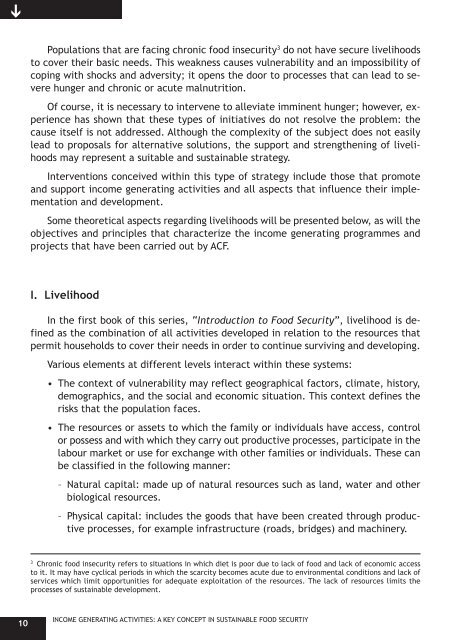Income-Generating Activities - Action Against Hunger
Income-Generating Activities - Action Against Hunger
Income-Generating Activities - Action Against Hunger
Create successful ePaper yourself
Turn your PDF publications into a flip-book with our unique Google optimized e-Paper software.
➔<br />
Populations that are facing chronic food insecurity 3 do not have secure livelihoods<br />
to cover their basic needs. This weakness causes vulnerability and an impossibility of<br />
coping with shocks and adversity; it opens the door to processes that can lead to severe<br />
hunger and chronic or acute malnutrition.<br />
Of course, it is necessary to intervene to alleviate imminent hunger; however, experience<br />
has shown that these types of initiatives do not resolve the problem: the<br />
cause itself is not addressed. Although the complexity of the subject does not easily<br />
lead to proposals for alternative solutions, the support and strengthening of livelihoods<br />
may represent a suitable and sustainable strategy.<br />
Interventions conceived within this type of strategy include those that promote<br />
and support income generating activities and all aspects that influence their implementation<br />
and development.<br />
Some theoretical aspects regarding livelihoods will be presented below, as will the<br />
objectives and principles that characterize the income generating programmes and<br />
projects that have been carried out by ACF.<br />
I. Livelihood<br />
In the first book of this series, “Introduction to Food Security”, livelihood is defined<br />
as the combination of all activities developed in relation to the resources that<br />
permit households to cover their needs in order to continue surviving and developing.<br />
Various elements at different levels interact within these systems:<br />
• The context of vulnerability may reflect geographical factors, climate, history,<br />
demographics, and the social and economic situation. This context defines the<br />
risks that the population faces.<br />
• The resources or assets to which the family or individuals have access, control<br />
or possess and with which they carry out productive processes, participate in the<br />
labour market or use for exchange with other families or individuals. These can<br />
be classified in the following manner:<br />
– Natural capital: made up of natural resources such as land, water and other<br />
biological resources.<br />
– Physical capital: includes the goods that have been created through productive<br />
processes, for example infrastructure (roads, bridges) and machinery.<br />
3<br />
Chronic food insecurity refers to situations in which diet is poor due to lack of food and lack of economic access<br />
to it. It may have cyclical periods in which the scarcity becomes acute due to environmental conditions and lack of<br />
services which limit opportunities for adequate exploitation of the resources. The lack of resources limits the<br />
processes of sustainable development.<br />
10<br />
INCOME GENERATING ACTIVITIES: A KEY CONCEPT IN SUSTAINABLE FOOD SECURTIY

















